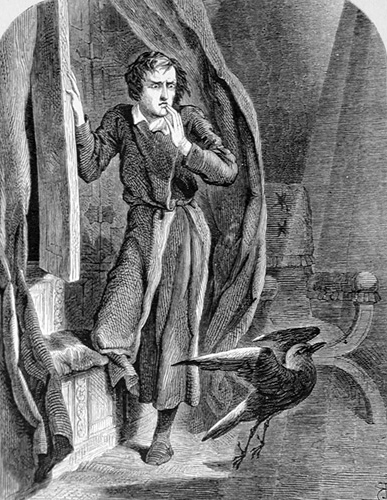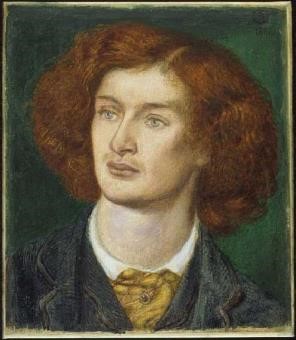|
Octameter
Octameter in poetry is a line of eight metrical feet. It is not very common in English verse. E.g.: - ''Trochaic'' :Once upon a midnight dreary, while I pondered, weak and weary :Over many a quaint and curious volume of forgotten lore- :While I nodded, nearly napping, suddenly there came a tapping :As of some one gently rapping, rapping at my chamber door :(Edgar Allan Poe, "The Raven") ''Iambic'' :I am the very model of a modern Major-General, :I've information vegetable, animal, and mineral, :I know the kings of England, and I quote the fights historical :From Marathon to Waterloo, in order categorical; :I'm very well-acquainted, too, with matters mathematical, :I understand equations, both the simple and quadratical, :About binomial theorem I'm teeming with a lot o' news, :With many cheerful facts about the square of the hypotenuse. :(W.S. Gilbert, "The Pirates of Penzance") ''Anapestic (acephalous)'' :Ere frost-flower and snow-blossom faded and fell, and the splendour of ... [...More Info...] [...Related Items...] OR: [Wikipedia] [Google] [Baidu] |
Trochaic Octameter
Trochaic octameter is a poetic meter with eight trochaic metrical feet per line. Each foot has one stressed syllable followed by an unstressed syllable. Trochaic octameter is a rarely used meter. Description and uses The best known work in trochaic octameter is Edgar Allan Poe's "The Raven", which uses five lines of trochaic octameter followed by a "short" half line (in reality, 7 beats). By the end of the poem, the latter half line takes on the qualities of a refrain. Another well-known work is Banjo Paterson's "Clancy of the Overflow", which uses four lines of trochaic octameter for each verse throughout. Other examples are Robert Browning's ''A Toccata of Galuppi's'', Alfred Tennyson's '' Locksley Hall'', and Rudyard Kipling's ''Mandalay''. (Compares Locksley Hall and Mandalay.) Lines in these poems are catalectic (' x ' x ' x ' x ' x ' x ' x ' ). A line of trochaic octameter is eight of these in a row: We can scan this with a 'x' mark representing an unstressed syllable and ... [...More Info...] [...Related Items...] OR: [Wikipedia] [Google] [Baidu] |
The Raven
"The Raven" is a narrative poem by American writer Edgar Allan Poe. First published in January 1845, the poem is often noted for its musicality, stylized language, and supernatural atmosphere. It tells of a distraught lover who is paid a mysterious visit by a talking raven. The lover, often identified as a student,Meyers, 163Silverman, 239 is lamenting the loss of his love, Lenore. Sitting on a bust of Pallas, the raven seems to further antagonize the protagonist with its constant repetition of the word "Nevermore". The poem makes use of folk, mythological, religious, and classical references. Poe claimed to have written the poem logically and methodically, with the intention to create a poem that would appeal to both critical and popular tastes, as he explained in his 1846 follow-up essay, "The Philosophy of Composition". The poem was inspired in part by a talking raven in the novel '' Barnaby Rudge: A Tale of the Riots of Eighty'' by Charles Dickens.Kopley & Hayes, 192 Poe ... [...More Info...] [...Related Items...] OR: [Wikipedia] [Google] [Baidu] |
Poetry
Poetry (derived from the Greek ''poiesis'', "making"), also called verse, is a form of literature that uses aesthetic and often rhythmic qualities of language − such as phonaesthetics, sound symbolism, and metre − to evoke meanings in addition to, or in place of, a prosaic ostensible meaning. A poem is a literary composition, written by a poet, using this principle. Poetry has a long and varied history, evolving differentially across the globe. It dates back at least to prehistoric times with hunting poetry in Africa and to panegyric and elegiac court poetry of the empires of the Nile, Niger, and Volta River valleys. Some of the earliest written poetry in Africa occurs among the Pyramid Texts written during the 25th century BCE. The earliest surviving Western Asian epic poetry, the '' Epic of Gilgamesh'', was written in Sumerian. Early poems in the Eurasian continent evolved from folk songs such as the Chinese ''Shijing'', as well as religious hymns (the S ... [...More Info...] [...Related Items...] OR: [Wikipedia] [Google] [Baidu] |
Meter (poetry)
In poetry, metre ( Commonwealth spelling) or meter (American spelling; see American and British English spelling differences#-re, -er, spelling differences) is the basic rhythm, rhythmic structure of a verse (poetry), verse or Line (poetry), lines in verse. Many traditional verse forms prescribe a specific verse metre, or a certain set of metres alternating in a particular order. The study and the actual use of metres and forms of versification are both known as prosody. (Within linguistics, "Prosody (linguistics), prosody" is used in a more general sense that includes not only poetic metre but also the rhythmic aspects of prose, whether formal or informal, that vary from language to language, and sometimes between poetic traditions.) Characteristics An assortment of features can be identified when classifying poetry and its metre. Qualitative versus quantitative metre The metre of most poetry of the Western world and elsewhere is based on patterns of syllables of particular typ ... [...More Info...] [...Related Items...] OR: [Wikipedia] [Google] [Baidu] |
Foot (poetry)
The foot is the basic repeating rhythmic unit that forms part of a line of verse in most Indo-European traditions of poetry, including English accentual-syllabic verse and the quantitative meter of classical ancient Greek and Latin poetry. The unit is composed of syllables, and is usually two, three, or four syllables in length. The most common feet in English are the iamb, trochee, dactyl, and anapest. The foot might be compared to a bar, or a beat divided into pulse groups, in musical notation. The English word "foot" is a translation of the Latin term ''pes'', plural ''pedes'', which in turn is a translation of the Ancient Greek ποῦς, pl. πόδες. The Ancient Greek prosodists, who invented this terminology, specified that a foot must have both an arsis and a thesis, that is, a place where the foot was raised ("arsis") and where it was put down ("thesis") in beating time or in marching or dancing. The Greeks recognised three basic types of feet, the iambic (where the r ... [...More Info...] [...Related Items...] OR: [Wikipedia] [Google] [Baidu] |
Edgar Allan Poe
Edgar Allan Poe (; Edgar Poe; January 19, 1809 – October 7, 1849) was an American writer, poet, editor, and literary critic. Poe is best known for his poetry and short stories, particularly his tales of mystery and the macabre. He is widely regarded as a central figure of Romanticism in the United States, and of American literature. Poe was one of the country's earliest practitioners of the short story, and considered to be the inventor of the detective fiction genre, as well as a significant contributor to the emerging genre of science fiction. Poe is the first well-known American writer to earn a living through writing alone, resulting in a financially difficult life and career. Poe was born in Boston, the second child of actors David and Elizabeth "Eliza" Poe. His father abandoned the family in 1810, and when his mother died the following year, Poe was taken in by John and Frances Allan of Richmond, Virginia. They never formally adopted him, but he was with them well ... [...More Info...] [...Related Items...] OR: [Wikipedia] [Google] [Baidu] |
The Pirates Of Penzance
''The Pirates of Penzance; or, The Slave of Duty'' is a comic opera in two acts, with music by Arthur Sullivan and libretto by W. S. Gilbert, W. S. Gilbert. Its official premiere was at the Fifth Avenue Theatre in New York City on 31 December 1879, where it was well received by both audiences and critics. Its London debut was on 3 April 1880, at the Opera Comique, where it ran for 363 performances. The story concerns Frederic, who, having completed his 21st year, is released from his apprenticeship to a band of tender-hearted pirates. He meets the daughters of Major-General Stanley, including Mabel, and the two young people fall instantly in love. Frederic soon learns, however, that he was born on the 29th of February, and so, technically, he has a birthday only once each leap year. His indenture specifies that he remain apprenticed to the pirates until his "twenty-first birthday", meaning that he must serve for another 63 years. Bound by his own sense of duty, Freder ... [...More Info...] [...Related Items...] OR: [Wikipedia] [Google] [Baidu] |
Algernon Charles Swinburne
Algernon Charles Swinburne (5 April 1837 – 10 April 1909) was an English poet, playwright, novelist, and critic. He wrote several novels and collections of poetry such as ''Poems and Ballads'', and contributed to the famous Eleventh Edition of the ''Encyclopædia Britannica''. Swinburne wrote about many taboo topics, such as lesbianism, sado-masochism, and anti-theism. His poems have many common motifs, such as the ocean, time, and death. Several historical people are featured in his poems, such as Sappho ("Sapphics"), Anactoria ("Anactoria"), and Catullus ("To Catullus"). Biography Swinburne was born at 7 Chester Street, Grosvenor Place, London, on 5 April 1837. He was the eldest of six children born to Captain (later Admiral) Charles Henry Swinburne (1797–1877) and Lady Jane Henrietta, daughter of the 3rd Earl of Ashburnham, a wealthy Northumbrian family. He grew up at East Dene in Bonchurch on the Isle of Wight. The Swinburnes also had a London home at Whitehall G ... [...More Info...] [...Related Items...] OR: [Wikipedia] [Google] [Baidu] |

.jpg)


